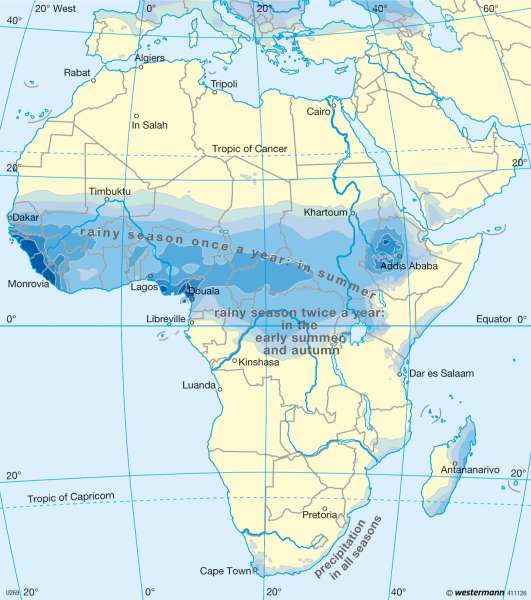July precipitation
Africa - Humid and wet-dry Tropics
978-3-14-100790-9 | Page 157 | Ill. 6

Information
The rhythm of life in Africa is shaped not only by temperature, but by the rainy, wet and dry seasons and the amount and seasonal distribution of rainfall being key environmental factors for plant growth.Classification of Climate Regions
Year-round rainfall is recorded only in the central Congo Basin, the region around the Niger delta and the Eastern Madagascar. With annual rainfall exceeding 2,000 millimetres, they are among the tropical regions with a humid climate all year round.
The deposits are tied to the position of the Intertropical Convergence Zone (ITC), which unite in the northeast and southeast trade winds causing convective clouds. Onshore equatorial westerly winds, called the Walker circulation, sometimes strengthen the precipitation.
This core is followed by a year-round equatorial rainfall with a largely dry winter season which lasts for a maximum of six months. Significantly, the rainfall here exceeds 1,000 millimetres annually.
The types of rainfall with two arid periods — a slight dry period in summer and a longer period in winter — characterises the rainfall regime of the dry savanna regions of Africa. Rainfall is present during the passage of each of the ITC towards the tropics as they retreat to the equator. With its certain deceleration at the zenith position of the sun, the connected advance of the ITC against the tropics and its retreat, are chronologically close together. The two rainfall maximums in tropical African borders develop into a summer rainy season (as tropical humid summer).
With annual rainfall totals significantly less than 1,000 millimetres, there are usually over eight arid months in the year. There are fully arid deserts in the area of the tropics — arid for up to twelve months with an annual rainfall of less than 250 millimetres. The core areas of tropical and sub-tropical drylands are both beyond the control of the ITC and the entropic westerly winds associated with rainfall.
Regional climate phenomena
On the west coast of South Africa, the aridity of the southern tropics on both sides is strengthened by the proximity of the cold Benguela current. Its cold water buoyancy cools the air masses above the sea. The superimposition by sinking, warm and dry air masses in the area of the Atlantic sub-tropical highs leads to the formation of a temperature inversion. A high-reaching convection, as would be necessary to form productive rainfall is suppressed. However, at the inversion threshold passage, dense fog drifts with the sea breezes up to 50 kilometres inland. Moisture from this damp fog, described in this process in the coastal deserts, is the most important source of moisture for the animals and plants of the Namib.
In contrast, in South Africa, a sub-tropical high pressure system over the south Indian Ocean controls year-round moist air masses which lead to significant rainfall on the east coast of Madagascar. The summer humidity in this region is typical of eastern sub-tropical weather, which is also common in East Asia.
The Maghreb region in the far north and the Cape region in the extreme south of Africa are under the influence of a sub-tropical winter rain climate. Rainfall occurs mainly in winter and spring through the winter relocation of west-wind jets connecting to "wandering cyclones" in the direction of the equator. However, in some mountainous areas rainfall amounts to over 1,000 mm.
East Africa and the Turkana Basin
East Africa moves within a special position of the climatic zones of Africa. The planetary position at the southern part of the constantly humid inner tropics is attributable to its northern part being intermittently outside the tropics. In fact, the Horn of Africa is all but surrounded by semi-desert and the annual rainfall is between 100 and 500 millimetres. This drought has two main causes: The regions are positioned in the controlling trade winds during the winter months from December to February and backed up by the continental dry air masses of the Arabian Peninsula. However, during the summer months from June to August, the Horn of Africa falls under the influence of the monsoon lows over the Persian Gulf and India. This means that the southeast trade winds in the southern hemisphere deflect to the southwest monsoon. The coastal area on the Gulf of Aden and in particular the "Danakil Depression" then comes to the leeside.
A further drying of East Africa, with annual rainfall of less than 500 millimetres, can be found just north of the equator in the Turkana Basin, northern Kenya. Again, the location in the lee of the Ethiopian highlands is one of the causes of this aridity. However, the lee effect is then carried throughout the northeast trade wind regime during the winter months. During the summer months from June to August, air masses in the form of valley wind from the Turkana basin are drawn through the high-altitude ascent over convective heating surfaces of the highlands. As compensation, subsiding air motions and cloud resolutions form above the sea.
Consequently, rainfall in East African tropical drylands only lasts for the duration of the rapid passage of the ITC in the transitional seasons, concentrated over a few days a year.
A. Siegmund, D. Volz, P. Frankenberg; Ü: C. Fleming




